Nava Atlas's Blog, page 59
February 11, 2020
Ariel by Sylvia Plath — a review and analysis
Ariel was the second published collection by Sylvia Plath (1932 – 1963). It came out two years after she took her own life at age thirty. Following is an analysis of Ariel by Sylvia Plath as well as a review, both from 1965, the year in which it was first published.
Plath’s poetry, considered part of the “confessional movement,” was influenced by Robert Lowell as well as by her friend, the poet Anne Sexton, who also explored dark themes and death in her work (and who, like Plath, committed suicide). Depression had been a constant companion, leading to a life of struggle that was reflected in her work.
Once Plath started to publish, her star quickly rose in the world of poetry. Her first collection, The Colossus, was published in 1960. Its poems were intense, personal, and delicately crafted. In Ariel, the beauty of craft remains even as it reveals the fissures growing in the poet’s psyche. According to the Penguin Companion to American Literature:
“The Colossus (1960) and the posthumous Ariel (1965) show a remarkable development. The first is a largely personal poetry, intense and delicately rendered, usually dealing with the relationship of the poet and a perceived object from which she seeks illumination, ‘that rare, random descent.’
It is controlled, serious verse but her later work shows new strains and pressures at work and becomes a poetry of anguished confession.”
The 1965 edition revealed the heavy hand of Ted Hughes. He had omitted twelve poems that Plath had earmarked for the collection, and included twelve others of his own choosing. In 2004, a restored edition of Ariel was published.
Following are two reviews of Ariel from 1965, the first of which is by A. Alvarez, a longtime champion of Plath and her poetry, and a poet in his own right.
. . . . . . . . . . .
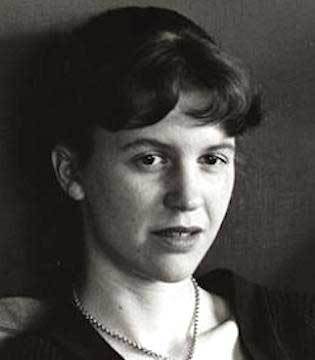
Learn more about Sylvia Plath
. . . . . . . . . . .
Poetry in Extremis — an analysis of Ariel
From the original review in The Observer, March 14, 1965, written by A. Alvarez: It is over two years now since Sylvia Plath died at the age of thirty, and in that time a myth has been gathering around her work.
It has to do with her extraordinary outburst of creative energy in the months before her death, culminating in the last few weeks when, as she herself wrote, she was at work every morning between four and seven, producing two sometimes three poems a day.
All of these last verses were intensely personal, nearly all were about dying. So when her death finally came it was prepared for and, in some degree, understood.
However wanton it seemed, it was also, in a way, inevitable, even justified, like some final unwritten poem.
The last works were something quite new in poetry. I wrote at the time in The Observer that Plath was “systematically probing that narrow, violent areas between the viable and the impossible, between experience which can be transmuted into poetry and that which is overwhelming.”
In order to tap knowingly the deep reservoirs of feeling that are released usually only in breakdown she was deliberately cutting her way through poetic conventions, shedding her old life, old emotions, old forms. Yet she underwent this process as an artist.
If the poems are despairing, vengeful, and destructive, they are at the same time tender, open, and also unusually clever, sardonic, hard minded:
Dying
Is an art, like everything else.
I do it exceptionally well.
I do it so it feels like hell.
I do it so it feels real.
I guess you could say I’ve a call.
The myth, then, is a diversion from the objective achievement. For the very reason that it has an originality that keeps it apart from any poetic fads. It is too concentrated and detached and ironic for “confessional” verse, with all hat implies of self-indulgent cashing-in on misfortunes; and it is violent without any deliberate exploitation of horrors and petty nastiness.
If these last poems could never have been predicted from her first collection, The Colossus, this is not simply because such a leap is always unforeseeable, but because her earlier absorption with style would, in the the usual order of things, have made it doubly hard for her to bore through the crust of mere craftsmanship and release the lava below.
Technically, the basic difference between the earlier and later poems is that the first were written for the eye, and the last for the ear. They need to be read aloud; they are original because she discovered in them her own speaking voice, her own identity.
So the poems run with an inner rhythm which alters with the pressure of feeling and allows the images, which came crowding in with an incredible fertility and accuracy, to shift into one another, define and modify one another, and rub off colors each on the next.
To take a straightforward example from “The Arrival of the Bee Box”:
I put my eye on the grid.
It is dark, dark.
With the swarm feeling of African hands
Minute and shrunk for export.
Black on black, angrily clambering.
How can I let them out?
It is the noise that appeals me most of all,
The unintelligible syllables.
It is like a Roman mob,
Small, taken one by one, but my god,
together!
I lay my ear to furious Latin,
I am not Caesar.
I have simply ordered a box of maniacs.
They can be sent back.
They can die, I need feed them nothing, I
am the owner.
It starts as simple narrative description; but as “dark” is repeated it is somehow made to reverberate inwardly, crystallizing into a metaphor which voices her underlying sense of threat.
That menace carries over into the next bit of description (of the noise) and shift, though another image, into wry helplessness (“I am not Caesar”); at which point a sense of proportion reasserts itself: “They can die … I am the am the owner.”
So a trivial incident gathers into a whole complicated nexus of feelings about the way her life is getting out of control. It is a brilliant balancing act between colloquial sanity and images which echo down and open up the depths.
Many of the poems are more difficult than that, rawer, more extreme. But all have that combination of exploratory invention, violent, threatened personal involvement and a quizzical edge of detachment. The poems are casual yet concentrated, slangy yet utterly unexpected.
They are works of great artistic purity and despite all the nihilism, great generosity.
Ariel is only a selection from a mass of work Plath left. Some of the other pomes have been printed here and there, some have been recorded, some exist only in manuscript. It is to be hoped that all this remaining verse will soon be published. As it is, this book is a major literary event.
. . . . . . . . . . .
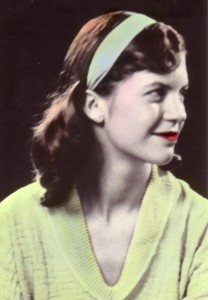
10 of Sylvia Plath’s Best-Loved Poems
. . . . . . . . . . .
A 1965 review of Ariel by Sylvia Plath
From the original review in The Age, Melbourne, Australia, July 10, 1965: Sylvia Plath was born in Boston, Massachusetts, in 1932. In 1956, while studying on a Fulbright grant, she met and married the poet Ted Hughes. In 1960 her first book of poems appeared, and in 1963, she committed suicide.
The poems written in the last three years of her life have been gathered in a volume titled Ariel.
They are difficult, uncertain poems, some extremely obscure and all primarily dependent on central images. Formal rhythm and the logic of rational statement are both dispensed with, the main principle of organization being a free-association technique.
How does a doomed poetess in her late twenties see death? Sylvia Plath was, in poetry at least, a stubbornly brave young woman, determined to face reality objectively, but at the same time neither to posture nor to cant.
The poems witness to a singularly pure sense of reality, a personality capable of many responses and of sustaining an attitude effectively. At one extreme she celebrates the ritual murder of her subconscious father-image in jangling staccato phrases parodying the clichés of agony column verse, and culminating in a Walpurgisnacht frenzy.
At the other she writes bitterly of her ability to survive:
It’s the theatrical
Comeback in broad day
To the same place, the same face, the same brute
Amused shout:
“A miracle!”
That knocks me out.
Some of her images take on forceful private meanings. Poppies are associated with violence and with the malignant blood cells of hemophilia, the Medusa head with the reality of death, bees with the life of the soul after death.
The last of the is a traditional usage, the other two subjective and personal. Such associations and identifications when they occur are almost always oblique and contribute to the enigmatic texture of the poetry.
Her achievement raises issues concerning the value of literature and its relation to life. The last poem suggests that words are dubious allies in the struggle to maintain a sense of reality. They are solid and fixed and resonant, abut as circumstances alter, they become emptied of meaning.
Years later I
Encounter them on the road —
Words dry and riderless,
The indefatigable hoof-taps
While
From the bottom of the pool, fixed
stars
Govern a life.
Nevertheless, her own work affirms the abiding value of literary creation, for poet and reader alike. It is no mean feat to have recorded an enduring attitude to death that embraces a sense of life in the face of suffering and weakness.
Plath’s poems are a tribute to the resourcefulness of the creative imagination and its capacity to render meaningful the hazardous course of an individual life.
. . . . . . . . . . . .
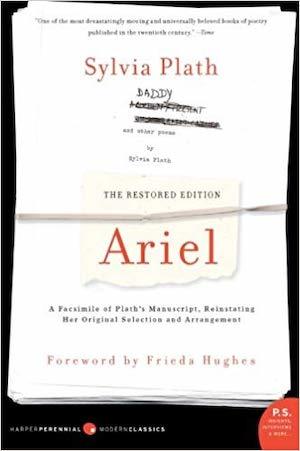
Ariel by Sylvia Plath (the restored edition) on Amazon*
. . . . . . . . . . . .
More about Ariel by Sylvia Plath
Reader discussion on Goodreads
Sylvia Plath’s Joy (The New Yorker)
A Close Reading of Ariel — The British Library
. . . . . . . . . . . .
*This is an Amazon Affiliate link. If the product is purchased by linking through, Literary Ladies Guide receives a modest commission, which helps maintain our site and helps it to continue growing!
The post Ariel by Sylvia Plath — a review and analysis appeared first on Literary Ladies Guide.
Ariel by Sylvia Plath — a review and analyisis
Ariel was the second published collection by Sylvia Plath (1932 – 1963). It came out two years after she took her own life at age thirty. Depression had been a constant companion, leading to a life of struggle that was reflected in her work. Following is an analysis of Ariel by Sylvia Plath as well as a review, both from 1965, the year in which it was first published.
Plath’s poetry, considered part of the “confessional movement,” was influenced by Robert Lowell as well as by her friend, the poet Anne Sexton, who also explored dark themes and death in her work (and who, like Plath, committed suicide).
Once Plath started to publish, her star quickly rose in the world of poetry. Her first collection, The Colossus, was published in 1960. Its poems were intense, personal, and delicately crafted. In Ariel, the beauty of craft remains even as it reveals the fissures growing in the poet’s psyche. According to the Penguin Companion to American Literature:
“The Colossus (1960) and the posthumous Ariel (1965) show a remarkable development. The first is a largely personal poetry, intense and delicately rendered, usually dealing with the relationship of the poet and a perceived object from which she seeks illumination, ‘that rare, random descent.’
It is controlled, serious verse but her later work shows new strains and pressures at work and becomes a poetry of anguished confession.”
The 1965 edition revealed the heavy hand of Ted Hughes. He had omitted twelve poems that Plath had earmarked for the collection, and included twelve others of his own choosing. In 2004, a restored edition of Ariel was published.
Following are two reviews of Ariel from 1965, the first of which is by A. Alvarez, a longtime champion of Plath and her poetry, and a poet in his own right.
. . . . . . . . . . .

Learn more about Sylvia Plath
. . . . . . . . . . .
Poetry in Extremis — an analysis of Ariel
From the original review in The Observer, March 14, 1965, written by A. Alvarez: It is over two years now since Sylvia Plath died at the age of thirty, and in that time a myth has been gathering around her work.
It has to do with her extraordinary outburst of creative energy in the months before her death, culminating in the last few weeks when, as she herself wrote, she was at work every morning between four and seven, producing two sometimes three poems a day.
All of these last verses were intensely personal, nearly all were about dying. So when her death finally came it was prepared for and, in some degree, understood.
However wanton it seemed, it was also, in a way, inevitable, even justified, like some final unwritten poem.
The last works were something quite new in poetry. I wrote at the time in The Observer that Plath was “systematically probing that narrow, violent areas between the viable and the impossible, between experience which can be transmuted into poetry and that which is overwhelming.”
In order to tap knowingly the deep reservoirs of feeling that are released usually only in breakdown she was deliberately cutting her way through poetic conventions, shedding her old life, old emotions, old forms. Yet she underwent this process as an artist.
If the poems are despairing, vengeful, and destructive, they are at the same time tender, open, and also unusually clever, sardonic, hard minded:
Dying
Is an art, like everything else.
I do it exceptionally well.
I do it so it feels like hell.
I do it so it feels real.
I guess you could say I’ve a call.
The myth, then, is a diversion from the objective achievement. For the very has an originality that keeps it apart from any poetic fads. It is too concentrated and detached and ironic for “confessional” verse, with all hat implies of self-indulgent cashing-in on misfortunes; and it is violent without any deliberate exploitation of horrors and petty nastiness.
If these last poems could never have been predicted from her first collection, The Colossus, this is not simply because such a leap is always unforeseeable, but because her earlier absorption with style would, in the the usual order of things, have made it doubly hard for her to bore through the crust of mere craftsmanship and release the lava below.
Technically, the basic difference between the earlier and later poems is that the first were written for the eye, and the last for the ear. They need to be read aloud; they are original because she discovered in them her own speaking voice, her own identity.
So the poems run with an inner rhythm which alters with the pressure of feeling and allows the images, which came crowding in with an incredible fertility and accuracy, to shift into one another, define and modify one another, and rub off colors each on the next.
To take a straightforward example from “The Arrival of the Bee Box”:
I put my eye on the grid.
It is dark, dark.
With the swarm feeling of African hands
Minute and shrunk for export.
Black on black, angrily clambering.
How can I let them out?
It is the noise that appeals me most of all,
The unintelligible syllables.
It is like a Roman mob,
Small, taken one by one, but my god,
together!
I lay my ear to furious Latin,
I am not Caesar.
I have simply ordered a box of maniacs.
They can be sent back.
They can die, I need feed them nothing, I
am the owner.
It starts as simple narrative description; but as “dark” is repeated it is somehow made to reverberate inwardly, crystallizing into a metaphor which voices her underlying sense of threat.
That menace carries over into the next bit of description (of the noise) and shift, though another image, into wry helplessness (“I am not Caesar”); at which point a sense of proportion reasserts itself: “They can die … I am the am the owner.”
So a trivial incident gathers into a whole complicated nexus of feelings about the way her life is getting out of control. It is a brilliant balancing act between colloquial sanity and images which echo down and open up the depths.
Many of the poems are more difficult than that, rawer, more extreme. But all have that combination of exploratory invention, violent, threatened personal involvement and a quizzical edge of detachment. The poems are casual yet concentrated, slangy yet utterly unexpected.
They are works of great artistic purity and despite all the nihilism, great generosity.
Ariel is only a selection from a mass of work Plath left. Some of the other pomes have been printed here and there, some have been recorded, some exist only in manuscript. It is to be hoped that all this remaining verse will soon be published. As it is, this book is a major literary event.
. . . . . . . . . . .

10 of Sylvia Plath’s Best-Loved Poems
. . . . . . . . . . .
A 1965 review of Ariel by Sylvia Plath
From the original review in The Age, Melbourne, Australia, July 10, 1965: Sylvia Plath was born in Boston, Massachusetts, in 1932. In 1956, while studying on a Fulbright grant, she met and married the poet Ted Hughes. In 1960 her first book of poems appeared, and in 1963, she committed suicide.
The poems written in the last three years of her life have been gathered in a volume titled Ariel.
They are difficult, uncertain poems, some extremely obscure and all primarily dependent on central images. Formal rhythm and the logic of rational statement are both dispensed with, the main principle of organization being a free-association technique.
How does a doomed poetess in her late twenties see death? Sylvia Plath was, in poetry at least, a stubbornly brave young woman, determined to face reality objectively, but at the same time neither to posture nor to cant.
The poems witness to a singularly pure sense of reality, a personality capable of many responses and of sustaining an attitude effectively. At one extreme she celebrates the ritual murder of her subconscious father-image in jangling staccato phrases parodying the clichés of agony column verse, and culminating in a Walpurgisnacht frenzy.
At the other she writes bitterly of her ability to survive:
It’s the theatrical
Comeback in broad day
To the same place, the same face, the same brute
Amused shout:
“A miracle!”
That knocks me out.
Some of her images take on forceful private meanings. Poppies are associated with violence and with the malignant blood cells of hemophilia, the Medusa head with the reality of death, bees with the life of the soul after death.
The last of the is a traditional usage, the other two subjective and personal. Such associations and identifications when they occur are almost always oblique and contribute to the enigmatic texture of the poetry.
Her achievement raises issues concerning the value of literature and its relation to life. The last poem suggests that words are dubious allies in the struggle to maintain a sense of reality. They are solid and fixed and resonant, abut as circumstances alter, they become emptied of meaning.
Years later I
Encounter them on the road —
Words dry and riderless,
The indefatigable hoof-taps
While
From the bottom of the pool, fixed
stars
Govern a life.
Nevertheless, her own work affirms the abiding value of literary creation, for poet and reader alike. It is no mean feat to have recorded an enduring attitude to death that embraces a sense of life in the face of suffering and weakness.
Plath’s poems are a tribute to the resourcefulness of the creative imagination and its capacity to render meaningful the hazardous course of an individual life.
. . . . . . . . . . . .

Ariel by Sylvia Plath (the restored edition) on Amazon*
. . . . . . . . . . . .
More about Ariel by Sylvia Plath
Reader discussion on Goodreads
Sylvia Plath’s Joy (The New Yorker)
A Close Reading of Ariel — The British Library
. . . . . . . . . . . .
*This is an Amazon Affiliate link. If the product is purchased by linking through, Literary Ladies Guide receives a modest commission, which helps maintain our site and helps it to continue growing!
The post Ariel by Sylvia Plath — a review and analyisis appeared first on Literary Ladies Guide.
February 6, 2020
A Street in Bronzeville by Gwendolyn Brooks (1945) — Two Reviews
Gwendolyn Brooks (1917 – 2000) was just twenty-eight years old when her first book, A Street In Bronzeville, was published in 1945. Following are two original reviews from 1945 of A Street in Bronzeville, which are typical of the universal praise it received.
The title of this poetry collection, whose title was a reference to Chicago’s South Side where the poet grew up, was very well reviewed and led to her winning a Guggenheim Fellowship.
Gwendolyn Brooks’ poetic work included sonnets, ballads, and blues rhythm in free verse. She also created lengthy lyrical poems, some of which were book-length. Each poem is an exquisitely crafted portrait of fictionalized (but true-to-life) characters and landmarks of the community.
From Bronzeville forward, Brooks’ poetry work revealed thoughtful, honest, and sometimes harsh reflections of urban African American life of the mid-twentieth century. Though her lens focused on black America, many of the themes of her poetry were universal, hence its broad appeal, and the respect it earned.
Poetry was how Gwendolyn Brook made her unique, singular life. In 1968, she was named Poet Laureate for the state of Illinois, and from 1985 to 1986, she served as Consultant in Poetry to the Library of Congress. Later in her life, she taught at a number of prestigious colleges and universities.
. . . . . . . . . . .
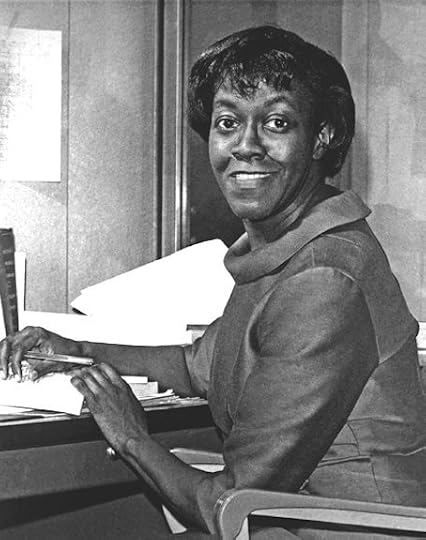
Learn more about Gwendolyn Brooks
. . . . . . . . . . .
Chicago Can Take Pride in New, Young Voice in Poetry
From the original review of A Street in Bronzeville in the Chicago Tribune, August 26, 1945, review by Paul Engle: The publication of A Street in Bronzeville is an exceptional event in the literary life of Chicago, for it is the first book of a solidly Chicago person.
Miss Brooks attended Englewood High School and Wilson Junior College. I hope they know it and are proud. But it is also an event of national importance, for Miss Brooks is the first Negro poet to write wholly out of a deep and imaginative talent.
Here is the story of a day on the South Side; it has the marvelous title of “The Sundays of Satin Legs Smith,” itself a poem. In it, Miss Brooks shows that she has a vigorous mind and uses it cunningly with slow concentration of word.
There are many poems about people and they’re all accurately human, alert, and moving. Miss Brooks goes through Chicago with her eyes wide open, taking the reader right inside the reality observed. There are keen notes on our mortal frailty, such as the amorous gentleman who, seeing an attractive woman, “wonders as his stomach breaks up in to fire and lights …”
How long it will be
Before he can, with reasonably
slight risk of rebuke, put
his hand on her knee.
There are poems which bear the immediate sense of the personal life strongly lived out:
It was quite a time for loving.
It was midnight. It was May.
But in the crowding darkness
Not a word did they say.
There is the quick observation of the shame and sorrow behind performance, as in “Queen of the Blues”:
Mame was singing
At the Midnight club.
And the place was red
With blues.
She could shake her body
Across the floor.
For what did she have
To lose?
The longest piece in the book is a sequence of poems about the soldier, called “Gay Chaps at the Bar.” They are the most controlled, the most intense poems in the book.
And they can be read for what they are and not, as the publishers want us to believe, as Negro poems. For they should no more be called Negro poetry than the poems of Robert Frost should be called white poetry. They’re poems for all readers who want warmth and softness, a quick hand and slow voice.
. . . . . . . . . .
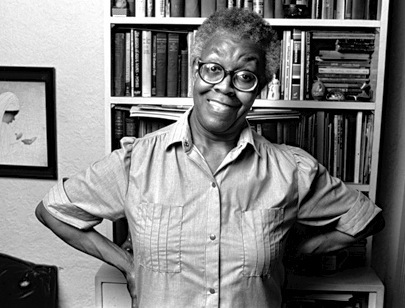
11 Iconic Poems by Gwendolyn Brooks
. . . . . . . . . .
Poignant Music
From the original review in the Hartford Courant, November 11, 1945: It’s an encouraging sign when any good poetry is published today, and even more encouraging when such poetry is by a gifted, unusual voice bespeaking Negro genius.
We have had the fine mastery and sense for the classic form of Countee Cullen, the poignant realism of Langston Hughes, and more recently, the powerful prose of Richard Wright. That the quality of rhythmic song is innate to the black pen has been persistently demonstrated by the work of these and other writers.
Now comes Gwendolyn Brooks, displaying all the old, ready aptitude for idiomatic music, but with a great deal of depth, original thinking, and expression.
Here is a fearlessly eloquent poet who can handle any mood or meter equally well, any subject and form, and at the same time give us poetry of ideas, not merely cerebral, which goes far beyond the bitterness against the “the White Race.” The bitterness is there, but it’s not the exclusively motivating factor.
Gwendolyn Brooks writes good satirical sketches, comic verse, love poems, acid sketches of Negro life and manners, poetry of the tenderest emotion and compassion, and verses about the the war that stab the conscience.
In a good deal of her work she prefers the use of consonance to rhyme, and somehow this manner seems curiously fitted to her purpose.
Illustrative of the poet’s depth of perception and trenchant expression, is the following poem:
The White Troops Had Their Order But the Negroes Looked Like Men
They had supposed their formula was fixed.
They had obeyed instructions to devise
A type of cold, a type of hooded gaze.
But when the Negroes came they were perplexed.
These Negroes looked like men. Besides, it taxed
Time and the temper to remember those
Congenital iniquities that cause
Disfavor of the darkness. Such as boxed
Their feelings properly, complete to tags —
A box for dark men and a box for Other —
Would often find the contents had been scrambled.
Or even switched. Who really gave two figs?
Neither the earth nor heaven ever trembled.
And there was nothing startling in the weather.
[read an analysis of this poem, “Gwendolyn Brooks and Positive Integration”]
If this is her first book, in the years to come we may certainly expect great poetry form Gwendolyn Brooks. All the promise and the poignant music are here.
. . . . . . . . . . .
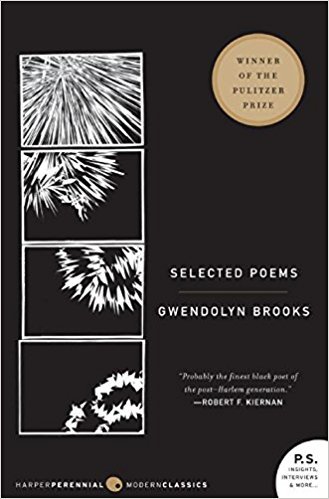
Gwendolyn Brooks page on Amazon*
*This is an Amazon Affiliate link. If the product is purchased by linking through, Literary Ladies Guide receives a modest commission, which helps maintain our site and helps it to continue growing!
The post A Street in Bronzeville by Gwendolyn Brooks (1945) — Two Reviews appeared first on Literary Ladies Guide.
February 1, 2020
11 Iconic Poems by Gwendolyn Brooks
Gwendolyn Brooks (1917 – 2000) sustained a decades-long career as a poet, and was recognized with many awards and honors during her lifetime. Following is a sampling of poems by Gwendolyn Brooks, with links to analyses following each one.
This selection doesn’t claim to be the most iconic of her poems, as that would be a tough call — so much of her work is a worthy part of the American literary canon. Brooks’s poetic work included sonnets, ballads, and blues rhythm in free verse. She also created lyrical poems, some of which were book-length.
Much of her poetry reflected on urban African-American life, though its themes were universal to the human experience. Her output was impressive, encompassing more than twenty books, including children’s books.
Brooks broke into book publishing in 1945 with A Street In Bronzeville, referring to an area in the Chicago’s South Side. It was an auspicious beginning, as this poetry collection led to her winning a Guggenheim Fellowship.
The epic, book-length poem Annie Allen (1949) earned Brooks a Pulitzer Prize in 1950, making her the first African-American to win this award.
In her storied career, Brooks was Poet Laureate for the state of Illinois, Consultant in Poetry to the Library of Congress, and taught at several prominent universities. But what she’s remembered for most was this skill with which she used her poetic voice to spread tolerance and understanding the black experience in America.
. . . . . . . . . . .

More about Gwendolyn Brooks
. . . . . . . . . .
The Children of the Poor
1
People who have no children can be hard:
Attain a mail of ice and insolence:
Need not pause in the fire, and in no sense
Hesitate in the hurricane to guard.
And when wide world is bitten and bewarred
They perish purely, waving their spirits hence
Without a trace of grace or of offense
To laugh or fail, diffident, wonder-starred.
While through a throttling dark we others hear
The little lifting helplessness, the queer
Whimper-whine; whose unridiculous
Lost softness softly makes a trap for us.
And makes a curse. And makes a sugar of
The malocclusions, the inconditions of love.
2
What shall I give my children? who are poor,
Who are adjudged the leastwise of the land,
Who are my sweetest lepers, who demand
No velvet and no velvety velour;
But who have begged me for a brisk contour,
Crying that they are quasi, contraband
Because unfinished, graven by a hand
Less than angelic, admirable or sure.
My hand is stuffed with mode, design, device.
But I lack access to my proper stone.
And plenitude of plan shall not suffice
Nor grief nor love shall be enough alone
To ratify my little halves who bear
Across an autumn freezing everywhere.
3
And shall I prime my children, pray, to pray?
Mites, come invade most frugal vestibules
Spectered with crusts of penitents’ renewals
And all hysterics arrogant for a day.
Instruct yourselves here is no devil to pay.
Children, confine your lights in jellied rules;
Resemble graves; be metaphysical mules.
Learn Lord will not distort nor leave the fray.
Behind the scurryings of your neat motif
I shall wait, if you wish: revise the psalm
If that should frighten you: sew up belief
If that should tear: turn, singularly calm
At forehead and at fingers rather wise,
Holding the bandage ready for your eyes.
(from Annie Allen, 1949)
Analysis of Children of the Poor
. . . . . . . . . .
The Mother
Abortions will not let you forget.
You remember the children you got that you did not get,
The damp small pulps with a little or with no hair,
The singers and workers that never handled the air.
You will never neglect or beat
Them, or silence or buy with a sweet.
You will never wind up the sucking-thumb
Or scuttle off ghosts that come.
You will never leave them, controlling your luscious sigh,
Return for a snack of them, with gobbling mother-eye.
I have heard in the voices of the wind the voices of my dim killed
children.
I have contracted. I have eased
My dim dears at the breasts they could never suck.
I have said, Sweets, if I sinned, if I seized
Your luck
And your lives from your unfinished reach,
If I stole your births and your names,
Your straight baby tears and your games,
Your stilted or lovely loves, your tumults, your marriages, aches,
and your deaths,
If I poisoned the beginnings of your breaths,
Believe that even in my deliberateness I was not deliberate.
Though why should I whine,
Whine that the crime was other than mine?—
Since anyhow you are dead.
Or rather, or instead,
You were never made.
But that too, I am afraid,
Is faulty: oh, what shall I say, how is the truth to be said?
You were born, you had body, you died.
It is just that you never giggled or planned or cried.
Believe me, I loved you all.
Believe me, I knew you, though faintly, and I loved, I loved you
All.
(from Blacks, 1987)
Analysis of The Mother
. . . . . . . . . .
We Real Cool
The Pool Players.
Seven at the Golden Shovel.
We real cool. We
Left school. We
Lurk late. We
Strike straight. We
Sing sin. We
Thin gin. We
Jazz June. We
Die soon.
(from The Bean Eaters, 1960)
Analysis of We Real Cool
. . . . . . . . . . .
To Be in Love
To be in love
Is to touch with a lighter hand.
In yourself you stretch, you are well.
You look at things
Through his eyes.
A cardinal is red.
A sky is blue.
Suddenly you know he knows too.
He is not there but
You know you are tasting together
The winter, or a light spring weather.
His hand to take your hand is overmuch.
Too much to bear.
You cannot look in his eyes
Because your pulse must not say
What must not be said.
When he
Shuts a door —
Is not there—
Your arms are water.
And you are free
With a ghastly freedom.
You are the beautiful half
Of a golden hurt.
You remember and covet his mouth
To touch, to whisper on.
Oh when to declare
Is certain Death!
Oh when to apprize
Is to mesmerize,
To see fall down, the Column of Gold,
Into the commonest ash.
. . . . . . . . . .
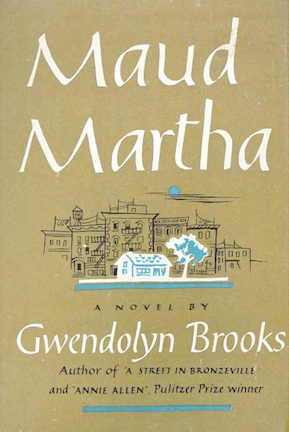
Poetic Quotes from Maud Martha by Gwendolyn Brooks
. . . . . . . . . .
Sadie and Maud
Maud went to college.
Sadie stayed home.
Sadie scraped life
With a fine toothed comb.
She didn’t leave a tangle in
Her comb found every strand.
Sadie was one of the livingest chicks
In all the land.
Sadie bore two babies
Under her maiden name.
Maud and Ma and Papa
Nearly died of shame.
When Sadie said her last so-long
Her girls struck out from home.
(Sadie left as heritage
Her fine-toothed comb.)
Maud, who went to college,
Is a thin brown mouse.
She is living all alone
In this old house.
(from Selected Poems , Harper & Row, 1963)
Analysis of Sadie and Maud
. . . . . . . . . . .
A Sunset of the City
Already I am no longer looked at with lechery or love.
My daughters and sons have put me away with marbles and dolls,
Are gone from the house.
My husband and lovers are pleasant or somewhat polite
And night is night.
It is a real chill out,
The genuine thing.
I am not deceived, I do not think it is still summer
Because sun stays and birds continue to sing.
It is summer-gone that I see, it is summer-gone.
The sweet flowers indrying and dying down,
The grasses forgetting their blaze and consenting to brown.
It is a real chill out. The fall crisp comes.
I am aware there is winter to heed.
There is no warm house
That is fitted with my need.
I am cold in this cold house this house
Whose washed echoes are tremulous down lost halls.
I am a woman, and dusty, standing among new affairs.
I am a woman who hurries through her prayers.
Tin intimations of a quiet core to be my
Desert and my dear relief
Come: there shall be such islanding from grief,
And small communion with the master shore.
Twang they. And I incline this ear to tin,
Consult a dual dilemma. Whether to dry
In humming pallor or to leap and die.
Somebody muffed it? Somebody wanted to joke.
(from Selected Poems , Harper & Row, 1963)
Analysis of Sunset of the City
. . . . . . . . . .
Boy Breaking Glass
Whose broken window is a cry of art
(success, that winks aware
as elegance, as a treasonable faith)
is raw: is sonic: is old-eyed première.
Our beautiful flaw and terrible ornament.
Our barbarous and metal little man.
“I shall create! If not a note, a hole.
If not an overture, a desecration.”
Full of pepper and light
and Salt and night and cargoes.
“Don’t go down the plank
if you see there’s no extension.
Each to his grief, each to
his loneliness and fidgety revenge.
Nobody knew where I was and now I am no longer there.”
The only sanity is a cup of tea.
The music is in minors.
Each one other
is having different weather.
“It was you, it was you who threw away my name!
And this is everything I have for me.”
Who has not Congress, lobster, love, luau,
the Regency Room, the Statue of Liberty,
runs. A sloppy amalgamation.
A mistake.
A cliff.
A hymn, a snare, and an exceeding sun.
(from Blacks, Third World Press, 1987)
Analysis of A Boy Breaking Glass
. . . . . . . . . . . .
The Bean Eaters
They eat beans mostly, this old yellow pair.
Dinner is a casual affair.
Plain chipware on a plain and creaking wood,
Tin flatware.
Two who are Mostly Good.
Two who have lived their day,
But keep on putting on their clothes
And putting things away.
And remembering . . .
Remembering, with twinklings and twinges,
As they lean over the beans in their rented back room that
is full of beads and receipts and dolls and cloths,
tobacco crumbs, vases and fringes.
(from The Bean Eaters, 1960)
Analysis of The Bean Eaters
. . . . . . . . . . .

Gwendolyn Brooks Quotes on Writing and Life
. . . . . . . . . . .
Jessie Mitchell’s Mother
Into her mother’s bedroom to wash the ballooning body.
“My mother is jelly-hearted and she has a brain of jelly:
Sweet, quiver-soft, irrelevant. Not essential.
Only a habit would cry if she should die.
A pleasant sort of fool without the least iron. . . .
Are you better, mother, do you think it will come today?
The stretched yellow rag that was Jessie Mitchell’s mother
Reviewed her. Young, and so thin, and so straight.
So straight! as if nothing could ever bend her.
But poor men would bend her, and doing things with poor men,
Being much in bed, and babies would bend her over,
And the rest of things in life that were for poor women,
Coming to them grinning and pretty with intent to bend and to kill.
Comparisons shattered her heart, ate at her bulwarks:
The shabby and the bright: she, almost hating her daughter,
Crept into an old sly refuge: “Jessie’s black
And her way will be black, and jerkier even than mine.
Mine, in fact, because I was lovely, had flowers
Tucked in the jerks, flowers were here and there . . .”
She revived for the moment settled and dried-up triumphs,
Forced perfume into old petals, pulled up the droop,
Refueled
Triumphant long-exhaled breaths.
Her exquisite yellow youth . . .
(from Selected Poems, Harper & Row, 1963)
Analysis of Jessie Mitchell’s Mother
. . . . . . . . . . .
A Song In The Front Yard
I’ve stayed in the front yard all my life.
I want a peek at the back
Where it’s rough and untended and hungry weed grows.
A girl gets sick of a rose.
I want to go in the back yard now
And maybe down the alley,
To where the charity children play.
I want a good time today.
They do some wonderful things.
They have some wonderful fun.
My mother sneers, but I say it’s fine
How they don’t have to go in at quarter to nine.
My mother, she tells me that Johnnie Mae
Will grow up to be a bad woman.
That George’ll be taken to Jail soon or late
(On account of last winter he sold our back gate).
But I say it’s fine. Honest, I do.
And I’d like to be a bad woman, too,
And wear the brave stockings of night-black lace
And strut down the streets with paint on my face.
(from Selected Poems, 1963)
Analysis of A Song In The Front Yard
. . . . . . . . . . .
kitchenette building
We are things of dry hours and the involuntary plan,
Grayed in, and gray. “Dream” makes a giddy sound, not strong
Like “rent,” “feeding a wife,” “satisfying a man.”
But could a dream send up through onion fumes
Its white and violet, fight with fried potatoes
And yesterday’s garbage ripening in the hall,
Flutter, or sing an aria down these rooms
Even if we were willing to let it in,
Had time to warm it, keep it very clean,
Anticipate a message, let it begin?
We wonder. But not well! not for a minute!
Since Number Five is out of the bathroom now,
We think of lukewarm water, hope to get in it.
(from Selected Poems, Harper & Row, 1963)
Analysis of kitchenette building
. . . . . . . . . . .

Gwendolyn Brooks page on Amazon*
. . . . . . . . . . .
*This is an Amazon Affiliate link. If the product is purchased by linking through, Literary Ladies Guide receives a modest commission, which helps maintain our site and helps it to continue growing!
The post 11 Iconic Poems by Gwendolyn Brooks appeared first on Literary Ladies Guide.
January 30, 2020
Testament of Youth by Vera Brittain (1933)
Testament of Youth by Vera Brittain (1893– 1970) has endured as this British author’s best known work. A memoir on how her life, and that of her generation, were forever marked by the losses endured as a result of World War I, it is indeed a touching testament.
Her brother, Edward, and her fiancé, Ronald Leighton were both killed during the war, and she never fully recovered from these tragic losses and placed them poignantly in the context of the horrors of the war.
As a result of the these losses, and the suffering she personally witnessed as a volunteer nurse during the war, led her to become a pacifist. She remained a dedicated member of the peace movement for the rest of her life.
Testament of Youth is now recognized as one of the most iconic memoirs of the twentieth century. Written with the perspective of time, Vera was a published author as well as a wife and mother when she began the book. She attempted to fictionalize the narrative at first, but it wasn’t working. In a 2013 homage to Testament of Youth on its eighty year anniversary, The Guardian (U.K.) wrote:
“It was only when she decided to write as herself that her authorial voice seemed to flow and the events she had endured were given a poignant immediacy to which readers could relate. In Testament of Youth, the words seemed to pour out of her, a potent mixture of rage and loss, underpinned by lively intelligence and fervent pacifist beliefs.”
The book was an instant success, with all 3,000 printed copies selling out on publication day. Over the next six years, the book sold more than 120,000 copies and earned praise from many writers, including Virginia Woolf, who wrote in her journal that she stayed up all night to finish reading it.
In the U.S., Testament of Youth was a critical and commercial success as well, praised as “heartbreakingly beautiful.” Here is a review from the time of its publication, capturing the flavor of the book and the important story and lessons in its pages.
In recent years, Testament of Youth has been brought back to life a number of television and film adaptations.
. . . . . . . . . . .
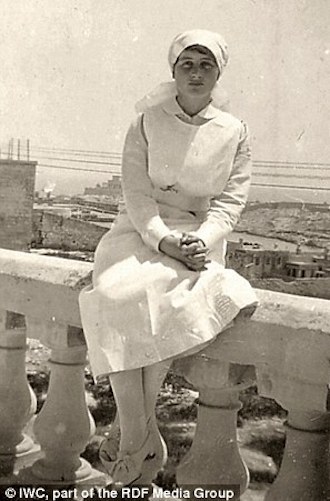
Vera Brittain as a World War I V.A.D. nurse
. . . . . . . . . .
A 1933 review of Testament of Youth
From the original review of Testament of Youth in the Salt Lake Tribune, November 12, 1933, by E.E. Hollis:
An autobiographical story of the war generation of England — moving, beautiful, and tragic
Testament of Youth by Vera Brittain is a book whose deep significance can hardly be overestimated. Of importance in its historical aspect, it is also a spiritual record of impelling power. Dealing with the war period, it is unlike any other story of those years.
Vera Brittain was of that generation to whom the war came to interrupt its preparation for life, to blight its budding hopes, and to put a new and ugly face upon its whole world. Her autobiography is a testament to what English youth suffered and lost during the World War I years.
Her story covers the first quarter of the twentieth century and makes startlingly clear the extraordinary changes wrought, in manners and morals, in society and politics. Her childhood as the daughter of the middle class is described briefly.
When the first rumbles of war were heard, Miss Brittain had succeeded, after much difficulty, in overcoming her father’s opposition to college for his “little girl.” She sought to be released from the boredom of “provincial young ladyhood” and was preparing for entrance to Oxford.
Life was opening joyfully; her bent for literature was to be satisfied and also dreams of love were stirring. She had found a most congenial companion in her brother Edward’s school intimate, Ronald Leighton, a brilliant young man.
Miss Brittain went to Oxford, but Edward and Ronald, who were to have started at the same time, were now in uniform. All she had worked so hard to achieve now seemed empty.
Joining the V.A.D.
By the spring of 1915 Miss Brittain had become a V.A.D. (Voluntary Aid Detachment — women who tended to wounded soldiers, of whom it was said later, “no one less than God Almighty could give a correct definition of the job of a V.A.D”), doing unpleasant tasks cheerfully, feeling that in a measure she shared the hardships her lover was enduring in France. She also lived on letters from the front.
. . . . . . . . . .
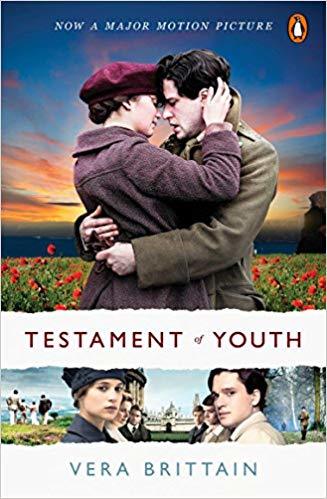
Testament of Youth by Vera Brittain on Amazon*
Losing a brother and a lover
At Christmas 1915 Ronald was to have his leave. On leave at home she waited with great anticipation fro his message, but the message was from his sister Clare, to say that Ronald had died of wounds at a Casualty Clearing station on the eve of his return.
Battling through her “individual hell,” she carried on at the London hospital, and was able to nurse her dearly loved brother, returning with convoys flowing back to the hospital from the battle on the Somme. Months later, Edward was killed in action on the Italian front.
Miss Brittain was sent on foreign service in Malta, in whose glamorous, sunlit beauty her heart wounds found some solace and healing. Later, she learned of the horrors of the general hospital at Etaples, through with passed a ceaseless storm of Tommies during the somber days when the German offensive rolled forward.
Here, too, she watched “the United States physically entering the war … our deliverers at last, marching; a formidable bulwark against the peril looming.”
The agony and falsity of war
All of these strenuous, anguishing experiences make engrossing, if painful, pages; it is through the letters of Ronald, Edward, and Miss Brittain herself, that one realizes the fierce agonies of their generation. It is not intended to minimize them, for this testament of youth is a challenge to forgetting, to the succeeding generation that they shall know what war means.
Miss Brittain insists, “The causes of war are always falsely represented; its honour is dishonest and its glory meretricious.” There is, too, comment on the injustices and follies in the conduct of war, resulting from mature reflection and understanding.
The record carries on through the post-war years, in which a maimed generation of youth struggled gallantly to gather up the broken pieces and rebuild life.
A return to Oxford, and to life
In 1919, the year “dominated by a thoroughly nasty Peace,” Vera Brittain returned to Oxford, accepted yet not welcomed as one of those “immoral” V.A.D.s. The story of her rise and activities as a journalist, lecturer, author, and internationalist, is scarcely less moving and important than the earlier chapters.
Testament of Youth is not one to read for pleasurable pastime, but one that insists on being read. It is alt once beautiful, terrible, and tragic, and written with courage and honesty.
More about Testament of Youth
My Mother Never Got Over the Loss of her Lover
Reader discussion on Goodreads
Testament of Youth: Book of a Lifetime
. . . . . . . . .
*This is an Amazon Affiliate link. If the product is purchased by linking through, Literary Ladies Guide receives a modest commission, which helps maintain our site and helps it to continue growing!
The post Testament of Youth by Vera Brittain (1933) appeared first on Literary Ladies Guide.
January 29, 2020
The Power of Her Pen: The Story of Groundbreaking Journalist Ethel L. Payne by Lesa Cline-Ransome
The story of Ethel L. Payne (1911 – 1991), the American journalist and correspondent, is a portrait of persistence, passion, and determination. Award-winning author Lesa Cline-Ransome has told her story in an inspiring book for younger readers. We’ll get to that after a brief introduction to Ethel Payne’s life and work.
Ethel grew up in a working-class African-American family in Chicago. She was a diligent student and avid reader, and showed an early interest in writing.
Pursuing the dream of becoming a reporter was no small feat for a black woman of Ethel’s era. A trailblazer from the start, she set her own path, which began in Washington, D.C. during World War II and in post-war Japan. Her experiences in both places shaped her as a journalist and activist.
Later in life, she said of her storied career: “I’ve been an eyewitness to so many profound things and so many changes … I’ve had a box seat on history, and that’s a rare thing.”
Ethel’s groundbreaking journey paralleled that of Alice Dunnigan, her contemporary and colleague. Like Alice, she was a correspondent for the Chicago Defender and worked as a White House correspondent.
And like Alice, Ethel angered president Eisenhower simply by asking direct questions about civil rights issues. Some newsmen thought that the two women competed for who could ask the toughest questions, but both were just trying to do their jobs well.
. . . . . . . . .
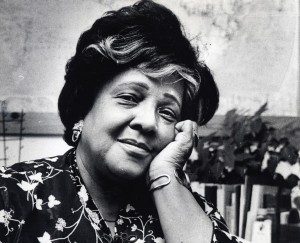
Photo: Washington Post
. . . . . . . . .
After being confronted with questions he didn’t care to answer, Eisenhower made a practice of ignoring both Ethel and Alice, looking past them to call on the mostly white, mostly male press corps. But the two women remained steadfast and true to their mission as journalists, and went on to achieve effective, award-winning careers.
Ethel was often called the “First Lady of the Black Press” for her stance as a civil rights journalist. But the best was yet to come when CBS hired her in 1972, making her the first female African-American political commentator on a national television network.
In an interview conducted late in her life and career, Ethel Payne summed up her life’s mission: “I stick to my firm, unshakeable belief that the black press is an advocacy press, and that I, as a part of that press, can’t afford the luxury of being unbiased … when it come to issues that really affect my people, and I plead guilty, because I think that I am an instrument of change.”
. . . . . . . . . .
The Power of Her Pen by Lesa Cline-Ransome
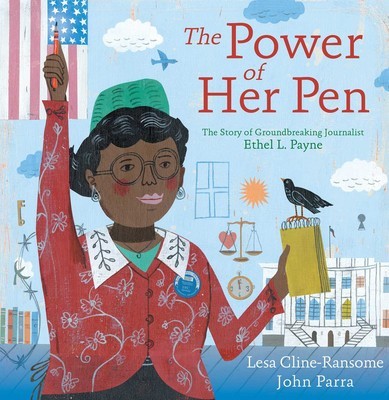
More about The Power of Her Pen on Simon & Schuster
The Power of Her Pen by Lesa Cline-Ransome on Amazon
. . . . . . . . . .
Lesa Cline-Ransome tells the story of Ethel Payne in a full-color book with lively illustrations by John Parra. Intended for young readers (though it can be enjoyed by all ages), it’s a wonderful introduction to Ethel’s life and work as one of a small group of African-American women journalists who broke through in the mid-twentieth century.
In a postscript, the author writes that pursuing journalism takes “a certain kind of grit and fearlessness.” She goes on to say that when the mainstream white press ignored stories of importance to the black community, “Ethel used her pen and her voice to report on the Montgomery Bus boycott, Rosa Parks, the plight of unwed mothers, race relations,” and more.
Through words and images, The Power of Her Pen follows Ethel through the challenges — as well as the joys — of being a bright and ambitious black female who sets her sights on journalism. What young reader with similar ambitions wouldn’t be struck by this passage:
“Ethel spend her school days daydreaming of life far beyond her neighborhood — except when she was in English class. There, her teacher, Miss Dixon, encouraged her writing. Her mother encouraged her at home. Ethel wrote during the day, and she read her stories to her family at night. The school wouldn’t let a black student work on the school newspaper, but, after reading Ethel’s writing, it did publish her very first story.”
Ethel came of age during the Great Depression, and after her father died while she was in her teens, money was tighter than ever. Determined to find a path to her dreams, she took writing classes at a local college that offered free tuition.
. . . . . . . . . .
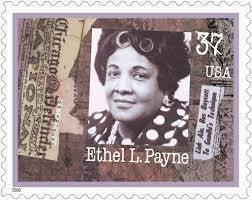
. . . . . . . . . .
Ms. Cline-Ransome guides the reader through Ethel’s rise in reporting, from covering black troops overseas during World War II to circling back to her home city to report for The Chicago Defender. Ethel covered civil rights in the wake of the Supreme Court’s Brown v. Board of Education ruling, and was able to triumph after being snubbed by President Eisenhower.
Ethel went on to effectively question presidents Kennedy, Johnson, Nixon, and Carter on civil rights matters (and to actually receive answers). We also learn that she marched with Dr. Martin Luther King, Jr. across the Edmund Pettus Bridge in Selma, AL, to protest for voting rights.
The book sums up Ethel Payne’s legacy, and indeed, conveys the importance of journalism in presenting the truth in order to affect change, particularly, in her case, as it pertained to the lives and struggles of African Americans:
“Her reporting highlighted their struggle for justice, equal pay, housing, and education. And, in he role of informing her readers, Ethel created awareness and activism in the fight for people across the globe.”
Lesa Cline-Ransome is the author of many award-winning and critically acclaimed nonfiction books for young readers, including Game Changers: The Story of Venus and Serena Williams; My Story, My Dance: Robert Battle’s Journey to Alvin Ailey; and Before She Was Harriet. She is also the author of the novel Finding Langston, which received a Coretta Scott King Honor Award and five starred reviews. She lives in the Hudson Valley region of New York. Learn more at LesaClineRansome.com.

See also: 10 Pioneering African-American Women Journalists
More about Ethel Payne
Ethel Payne, “First Lady of the Black Press,” Asked Questions No One Else Would”
If This Trailblazing Journalist Hadn’t Been a Black Woman, You Would Know Her Name
Wikipedia
Women’s History
. . . . . . . . . .
*This is an Amazon Affiliate link. If the product is purchased by linking through, Literary Ladies Guide receives a modest commission, which helps maintain our site and helps it to continue growing!
The post The Power of Her Pen: The Story of Groundbreaking Journalist Ethel L. Payne by Lesa Cline-Ransome appeared first on Literary Ladies Guide.
January 26, 2020
The Sea, The Sea by Iris Murdoch (1978)
The Sea, the Sea by Iris Murdoch (1919 – 1999) was the prolific British author’s nineteenth novel. Following is a review and analysis from 1978, the year in which it was published.
The story of Charles Arrowby, a self-involved and egotistical retired theater director begins as he is setting about to write his memoir. To focus on this task, he secludes himself in a house, not surprisingly, near the sea. He muses:
“Then I felt too that I might take this opportunity to tie up a few loose ends, only of course loose ends can never be properly tied, one is always producing new ones. Time, like the sea, unties all knots. Judgements on people are never final, they emerge from summings up which at once suggest the need of a reconsideration. Human arrangements are nothing but loose ends and hazy reckoning, whatever art may otherwise pretend in order to console us.”
As he looks back over his life, he encounters his first, adolescent love, now much older and hardly recognizable. This upends his quiet plans as he grows obsessed with her, and sets off some farcical situations.
The Sea, The Sea was critically acclaimed and won the 1978 Booker Prize.
. . . . . . . . . .
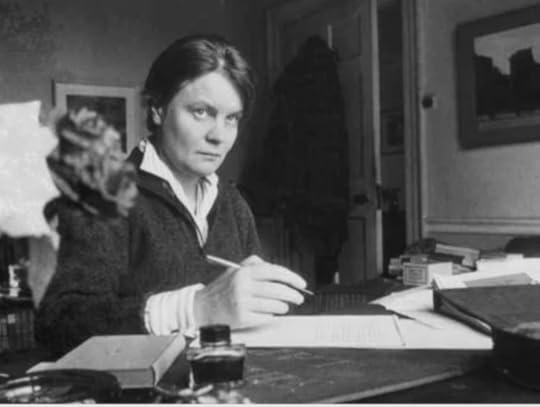
Learn more about Iris Murdoch
. . . . . . . . . .
A 1978 Review of The Sea, The Sea by Iris Murdoch
From the original review of The Sea, The Sea by Iris Murdoch by Lorna Sage in the Observer Sun, London, August 27, 1978:
“Those who want to be saved,” wrote Iris Murdoch in her book on Plato, “should look at the stars and talk philosophy, not write or go to the theatre.”
It’s a fair summary of the plot of this novel. Not the message, of course. She is adept as ever at keeping her philosophy and her fiction in their separate realms, and The Sea, The Sea is inventive, gossipy, and fantastic, not at all preachy.
Nonetheless she has lumbered her characters with some of the more choice (i.e. insoluble, fascinating, humiliating) problems her philosophical alter ego has been exploring lately.
Charles Arrowby, renowned theatre director
The hero, Charles Arrowby, is a retired and celebrated theatre director and, it goes almost without saying, a sentimental cynic and a monster of egotism.
He sets out to write his memoirs from his seaside retreat with a cozy reminiscent sense of achievement — modestly comparing himself to Prospero, abjuring the old magic, etc. — only to be stopped in his tracks by a dreadful and spectacular haunting he has not, for once, engineered.
The life he’d foreseen — the windy, wave-beaten promontory, the sketchy “nature study,” the small gourmet treats (Iris Murdoch does wonders of sneaky characterization by having him gloat over his solitary, greedy, unappetizing menus), the lighthearted pleasure of torturing infatuated ex-mistresses — all begins to disintegrate, as people and nameless things from the past crowd into his field of vision.
A first love reappears
The most embarrassing of his apparitions is a Loch Ness-style sea monster fainting in coils; the most unlikely his first and lost love, now a shy, lumpy 60-year-old who turns out to be living in a twee bungalow round the corner with her equally substantial husband.
Shaken but undefeated (indeed, rather roused by the challenges — this is where the real fun starts), Charles takes them all on, and tries mightily to fashion them into an Arrowby production.
Hartley, the lost love, he casts in the role of an aging Andromeda; himself, of course, as Perseus. Her husband, Ben, is obviously the sea beast, though he can’t swim.
And this is only one of many ingenious ploys; ‘resting’ actor friends who visit out of curiosity, and stay out of malice, get fitted in, too, like sad Gilbert, who thinks he’s in the Tempest plot, and saws wood in great quantities to prove it.
. . . . . . . . . .
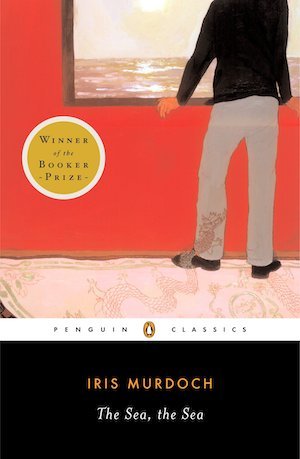
The Sea, The Sea by Iris Murdoch on Amazon*
. . . . . . . . . .
A change of tone from funny to strange
So far, the book is very funny, and exactly conveys the tone and feel of a theatre world where people become, as it were, addicts of illusion, accustomed to manipulate or be manipulated.
When Charles steps decisively over into reality, though, and kidnaps Hartley, the tone changes: he comes up against a level of living, of sheer, mysterious ordinariness he knows nothing about. Her marriage may be stuffy, changeless, tasteless, even unhappy, but it’s real, and Charles can only eavesdrop on it, obscenely, like a Peeping Tom.
At this point, he starts to get the queasy feeling Iris Murdoch’s egotistical characters all dread: “I had lost control of my life and of the lives with which I was meddling … I had awakened some sleeping demon, set going some deadly machine.”
A breathless climax and an epiphany
His personal sorcery suddenly fails to work, the forces of necessity (chaos, the amorphous surrounding sea) take over, in one of those manic, violent, coincidental climaxes that leave the characters (and the reader) breathless. Death, along with marriage, is an inevitable touchstone of reality for Murdoch.
Charles sees for perhaps the first time in his life round the edge of his own fantasizing ego, beyond the picturesque intrigues and passionate delusions that have been the stuff of his personal and professional life. He learns, in short, to look at the stars and talk philosophy.
And this is where Murdoch’s Platonic dialog with herself comes to the foreground. What fascinates her and irritates her more than anything is the wasteful paradox of self-knowledge — the fact that we can truly know ourselves only by the crashing messily not the limits of our freedom.
A melding of fiction and philosophy
This book has a saint, in the unlikely person of Charles’s cousin James, an ex-Army man who discovered Buddhism while engaged in Tibet, and who performs several startling miracles to rescue the others from their nightmare. James, though, is thankfully a minor character, a mere catalyst.
Charles is the hero because his theatrical memoir-scribbling existence is the best (i.e. most problematic) metaphor for how most of us function. By the end, of course, he has mostly mislaid his momentary vision, and is back playing games.
I suppose this is what Iris Murdoch means when she distinguishes between philosophy and fiction — that what the novel does superlatively is mirror our continuing confusion and muddle.
The Sea, The Sea, certainly manages an exhilarating, and occasionally dreadful anarchy. Her habit of inventing golden boys, for instance, and then killing them off as symbols of lost dreams (Beautiful Joe in Henry and Cato; equally beautiful and doomed Titus in this book) is getting to be worrisome in a way that I don’t think has much to do with Plato.
. . . . . . . . . .
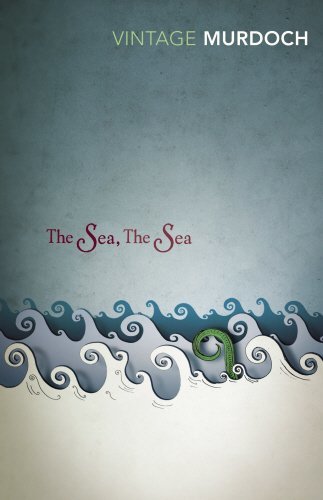
. . . . . . . . . .
Quotes from The Sea, The Sea
“The theatre is certainly a place for learning about the brevity of human glory: oh all those wonderful glittering absolutely vanished pantomimes.”
. . . . . . . . . .
“I’ve felt as if I didn’t exist, as if I were invisible, miles away from the world, miles away. You can’t imagine how much alone I’ve been all my life.”
. . . . . . . . . .
“There was something factitious and brittle and thereby utterly feminine about her charm which made me want to crush her, even to crunch her. She had a slight cast in one eye which gives her gaze a strange concentrated intensity. Her eyes sparkle, almost as if they were actually emitting sparks. She is electric. And she could run faster in very high-heeled shoes than any girl I ever met.”
. . . . . . . . . .
“I felt a deep grief that crouched and stayed still as if it was afraid to move.”
. . . . . . . . . .
“I ate and drank slowly as one should (cook fast, eat slowly) and without distractions such as (thank heavens) conversation or reading. Indeed eating is so pleasant one should even try to suppress thought. Of course reading and thinking are important but, my God, food is important too.
How fortunate we are to be food-consuming animals. Every meal should be a treat and one ought to bless every day which brings with it a good digestion and the precious gift of hunger.”
. . . . . . . . . .
“What a queer gamble our existence is. We decide to do A instead of B and then the two roads diverge utterly and may lead in the end to heaven and to hell. Only later one sees how much and how awfully the fates differ. Yet what were the reasons for the choice? They may have been forgotten. Did one know what one was choosing? Certainly not.”
. . . . . . . . . .
“However life, unlike art, has an irritating way of bumping and limping on, undoing conversions, casting doubt on solutions, and generally illustrating the impossibility of living happily or virtuously ever after.”
. . . . . . . . . .
*This is an Amazon Affiliate link. If the product is purchased by linking through, Literary Ladies Guide receives a modest commission, which helps maintain our site and helps it to continue growing!
The post The Sea, The Sea by Iris Murdoch (1978) appeared first on Literary Ladies Guide.
January 23, 2020
Vera Brittain
Vera Brittain (December 29, 1893– March 29, 1970) was a British memoirist, poet, essayist, and novelist whose work and life were forever marked by the losses she endured as a result of World War I. She’s best remembered for her classic memoir, Testament of Youth (1933).
As a young wartime nurse, she tended to wounded soldiers in several countries. Her brother and her fiancé were killed during the war. Brittain never fully recovered from the tragic loss, and the horrors of the war are poignantly depicted in her writings.
The suffering she witnessed inspired her to become a pacifist after the war, and she was an active, dedicated member of the peace movement for the rest of her life.
Early Life and Education
Vera Brittain was born in the Staffordshire town of Newcastle-under-Lyme. Her parents, Thomas and Edith Brittain, owned paper mills in the towns of Hadley and Cheddleton.
The family moved to Macclesfield in the Cheshire area when Vera was 18 months of age, and they lived in Buxton, a spa town, when Vera was aged 11 to 13. At the age of 13, Vera attended St. Monica’s, a boarding school in Surrey.
Against her father’s wishes, she majored in English literature at Oxford University, entering at the age of twenty.
. . . . . . . . .
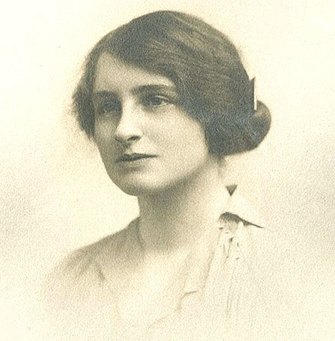
. . . . . . . . .
World War I service and tragic losses
While she was an Oxford student in 1915, the university granted her leave to serve as a nurse for those wounded in the war. She was one of the first female students to be granted this type of leave.
Serving as a Voluntary Aid Detachment nurse, she cared for soldiers in Buxton and London before being sent to tend to the wounded in Malta and France.
Brittain’s fiance, Roland Leighton, was tragically killed shortly before Christmas in 1915. While repairing barbed wire in a no-man’s land late one night, he was shot by a German sniper.
Vera’s brother, Edward, was killed in action while serving in Italy in the summer of 1918. Her brother’s close friends, Geoffrey Thurlow and Victor Richardson, also lost their lives during the war. These losses profoundly impacted Brittain, and she would eventually use writing as a vehicle to express her pain.
In a 1916 letter to Edward, Vera wrote, “If the war spares me, it will be my one aim to immortalise in a book the story of us four.” She would go on to do just that, and the book, Testament of Youth, became a British classic.
. . . . . . . . .

. . . . . . . . .
Friendship with Winifred Holtby
After the war, Vera Brittain returned to Oxford University and changed her major to history. She formed a close friendship with Winifred Holtby and had aspirations of becoming an established author in London. This deep friendship, cut short by Holtby’s untimely death at age 37, was described in this 2013 homage to Brittain and Holtby’s friendship in The Telegraph (U.K.)
“As writers they were the most decisive influences on each other’s work. It was a relationship, above all, that made significant contributions to the writing of two bestselling masterpieces, which have stood the test of time: Brittain’s memoir of the cataclysmic effect of the First World War on her generation, Testament of Youth, and Holtby’s South Riding, her novel about a Yorkshire community struggling in the grip of the Great Depression of the Thirties.
After Holtby’s death, Brittain memorialized their friendship in a biography of Winifred which, she hoped, would remind people ‘of the glowing, radiant generous, golden creature whom we have lost.’ This friendship has achieved iconic status, as an example of an emotionally and intellectually supportive relationship between two women, of a kind rarely recorded in literature.”
. . . . . . . . .
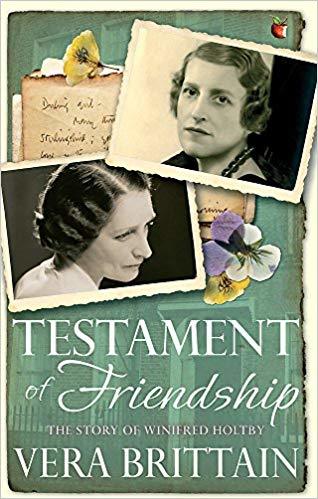
. . . . . . . . .
First publications
In August 1919, Brittain’s first book of poetry was published. Entitled Verses of a V.A.D., it included a poem dedicated to Edward.
The Dark Tide, her first novel, followed in 1923. The work detailed life at Oxford University and was controversial for its discussion of sexism at the institution. Another novel, Anderby Wold, was published that same year.
Marriage and family
Vera married the political scientist George Catlin in 1925. The couple had two children. Their son, John, was born in 1927 and became an artist with whom Vera reportedly had a difficult relationship. Shirley, the couple’s daughter, was born in 1930 and became a member of the British parliament.
Testament of Youth
In 1933, Brittain published her memoir, Testament of Youth. Now recognized as one of the most iconic memoirs of the twentieth century, the work tells of the experiences she endured during World War I. Vera’s fiancee, her brother, and her brother’s friends who died are all prominently featured in the book.
Typed on a typewriter in the study at her home in Chelsea, Vera worked on the book for seven hours each day while her young children played. At first she attempted to fictionalize the narrative, but without success. It was only when she let it flow as a memoir that it fell into place.
A 2013 homage to Testament of Youth on its eighty year anniversary, The Guardian (U.K.) wrote:
“It was only when she decided to write as herself that her authorial voice seemed to flow and the events she had endured were given a poignant immediacy to which readers could relate. In Testament of Youth, the words seemed to pour out of her, a potent mixture of rage and loss, underpinned by lively intelligence and fervent pacifist beliefs.”
The book was instantly successful, with all 3,000 printed copies selling out on publication day.
Over the next six years, the book sold more than 120,000 copies and earned praise from writer Virginia Woolf, who wrote in her journal that she stayed up all night to finish reading it. After being published in the United States, Testament of Youth was lauded as “heartbreakingly beautiful.”
Works after 1930
South Riding, was published in 1936. Her 1940 work, Testament of Friendship, was a tribute to Winifred Holtby, who passed away in 1935.
In 1944, she published Seeds of Chaos, a work that spoke out against World War II. Testament of Experience, another memoir published in 1957, chronicles the years between 1925 to 1950.
Brittain was quite a prolific author of nonfiction in addition to her autobiographical series and a smaller number of novels. One of these was a book about Radclyffe Hall‘s trials. A selection of nonfiction works are listed toward the end of this post.
Pacifism
In the 1920s, Brittain was a frequent speaker at events for the League of Nations Union, and she spoke at a peace rally with Dick Sheppard in 1936. In 1937, she joined the Peace Pledge Union and the Anglican Pacifist Fellowship.
In the 1930s, she regularly contributed articles to Peace News, a pacifist magazine. After the outbreak of World War II, she wrote a series entitled Letters to Peacelovers and worked as a fire warden. Brittain later became an editorial board member for Peace News, writing articles against colonialism and apartheid.
Later years and legacy
After being injured in a fall in November 1966, Brittain’s health slowly declined. She passed away in Wimbledon at the age of 76 on March 29, 1970. As requested in her will, Vera’s ashes were scattered over her brother’s grave in Italy.
Brittain’s work helped people of later generations understand World War I through her eyes. To this day, her writings inspire others to work for peace.
Testament of Youth, her most famous literary contribution, was made into a feature film in 2014. Plaques mark the locations of her former homes in Newcastle-under-Lyme, Buxton, and London, and a promenade in Hamburg, Germany is named for her.
. . . . . . . . .

Vera Brittain page on Amazon*
More about Vera Brittain
Major Works
Poetry
Verses of a V.A.D. (1919)
Poems of the War and After (1934)
Memoir
Testament of Youth: An autobiographical study of the years 1900-1925 (1933)
Testament of Experience: An autobiographical story of the years 1925-1950 (1950)
Testament of Friendship: The Story of Winifred Holtby (1940)
Novels
The Dark Tide (1923)
Anderby Wold (1923)
Honourable Estate (1936)
Born 1925: A Novel of Youth (1949)
Nonfiction (highly selected)
Women’s Work in Modern England.(1928)
Halcyon; or, The future of monogamy (1929)
Thrice a Stranger (1938)
Humiliation with Honour (1943)
Seeds of Chaos: What mass bombing really means. (1944)
On Becoming a Writer (1947)
Search after Sunrise. London: Macmillan (1951)
Lady into Woman: A history of women from Victoria to Elizabeth II (1953)
The Women at Oxford: A fragment of history (1960)
The Rebel Passion: A short history of some pioneer peacemakers (1964)
Radclyffe Hall: A case of obscurity (1969)
More information and sources
All Poetry
Reader discussion of Vera Brattain’s works on Goodreads
Wikipedia
Losing Her First Love Haunted My Mother All Her Life
Papers of Vera Brittain at the Bodleian Library, Oxford University
Biographies and letters
Chronicle of Youth: The War Diary, 1913 – 1917, ed. by Alan Bishop with Terry Smart (1981)
Testament of a Generation: The journalism of Vera Brittain and Winifred Holtby ,
ed. by Paul Berry & Alan Bishop London (1985)
Vera Brittain by Hilary Bailey (1987)
Letters from a Lost Generation, ed. by Alan Bishop and Mark Bostridge (1998)
Vera Brittain: A Life, by Paul Berry and Mark Bostridge (1995, 1996, 2001, 2008)
Vera Brittain: A Feminist Life, by Deborah Gorham, (2000)
Vera Brittain and the First World War, by Mark Bostridge (2014)
Film adaptations
Testament of Youth (2014)
. . . . . . . . .
*This is an Amazon Affiliate link. If the product is purchased by linking through, Literary Ladies Guide receives a modest commission, which helps maintain our site and helps it to continue growing!
The post Vera Brittain appeared first on Literary Ladies Guide.
January 17, 2020
Elizabeth Taylor
Elizabeth Taylor (July 3, 1912 – November 19, 1975) was a British novelist and author of short stories who is generally acknowledged to be underrated — a brilliant writer who deserves to be more widely read. She is not to be confused with the iconic actress with the same name.
Writers as distinct as Antonia Fraser, Barbara Pym and Kingsley Amis admired her work, which are filled with both impassioned and lonely characters.
Upbringing and Education
In 1912, she was born Dorothy Betty Coles in Reading England. She wouldn’t begin to refer to herself as Elizabeth until the early 1930s. As a child, she was very close to her mother, Elsie May Fewtrell. Her father, Oliver, was an insurance inspector.
In September 1923, Betty attended Abbey School, a well-known Christian school. Although she would later become an atheist). She struggled with mathematics but received 99% on an English paper, which was the highest mark ever received by an Abbey School student (the one percent deducted to acknowledge that everyone’s handwriting could stand improvement.
Betty officially completed school in Berkshire in July 1930 but actually had finished before the previous Christmas. Even then, at seventeen, she aspired to write. She would write about this later, in a 1951 issue of The Bookclub Magazine: “I wanted to be a novelist, but it is not easy suddenly to be that at 17. I spent a year trying to write, despairing.”
Early reading and writing
As a child, the first full-length book Betty read was Lewis Carroll’s Alice’s Adventures in Wonderland (a book which also had a profound impact on American writer Natalie Babbitt).
She also read (and reread) the Bastable books by E. Nesbit and she enjoyed collecting comic versions of classic stories by Victor Hugo, Jules Verne, and Wilkie Collins.
As an older girl, she read Crime and Punishment, and biographer Nicola Beauman notes that Betty’s Commonplace Book, encompassing 1928 through 1936, also includes other specific works, like The Waves and To the Lighthouse by Virginia Woolf and Persuasion by Jane Austen.
Other authors were also recorded: Katherine Mansfield, Siegfried Sassoon, William Butler Yeats, Edward Thomas, D. H. Lawrence, Thomas Mann, and Richard Church.
As a young woman, Elizabeth often borrowed books from the Boots Libraries and, after briefly working as a governess elsewhere, she worked as a librarian under their auspices, first in Maidenhead, then in High Wycombe.
After her own work had been published, years later, Elizabeth identified specific authors as having been influential for her development as a novelist and short story writer.
The works of Jane Austen, E.M. Forster, Anton Chekhov, and Virginia Woolf were particularly important, along with Samuel Richardson, Henry Fielding, and Ivan Turgenev. Throughout her life, she would reread Jane Austen regularly: her Martin Secker set was faded and worn from frequent use.
She also remarked on the work of two contemporary writers: Ivy Compton-Burnett and Elizabeth Bowen.
Marriage, family, and love
After Elizabeth moved to Buckinghamshire, an area where the family had often vacationed, she joined the Little Theatre Club; she remained a member and performed, from 1932 to 1935, in High Wycomb.
In later years, literary reviewers and critics would comment on her ability to sketch scenes on the page, which suggests that her theatrical experience also impacted her creative work.
Another member of the troupe was John William Kendall Taylor, the man she would marry on March 11, 1936 in Caxton Hall, Westminster. This year – 1936 – was particularly significant for Elizabeth. She also joined the Communist Party (in response to concerns about rising unemployment rates and the rise of fascism), lost her mother, had a miscarriage, and she met Ray Russell.
With John Taylor, Elizabeth had a son and daughter: Renny and Joanna, in 1937 and 1941 respectively. While married, however, she had an ongoing – but intermittent – romantic involvement with Ray Russell (although he was away, and a prisoner of war, for four years during WWII).
The letters Elizabeth and Ray wrote were a primary source for Nicola Beauman’s biographical research for The Other Elizabeth Taylor (2009).
“I am always disconcerted when I am asked for my life story, for nothing sensational, thank heavens, has ever happened,” Elizabeth explains in a 1953 article for the New York Herald Tribune.
She elaborates: “I dislike much travel or change of environment and prefer the days (each with its own domestic flavor) to come round almost the same, week after week. Only in such circumstances can I find time or peace in which to write.”
First novel and adjusting to the writing life
While her husband was away in the Royal Air Force, Elizabeth wrote At Mrs. Lippincote’s, which was published in 1945. After Patience Ross at A.M. Heath secured a publisher for this debut novel, Elizabeth immediately began to work on her next.
She wrote slowly, in longhand. “When at the end of the war, I first had a novel published,” she outlines in the Herald Tribune article, “I received the proofs in trembling excitement. Now I am filled with anxiety, for I am a poor proof-reader.”
>In 1949, in a letter to novelist Elizabeth Bowen, Elizabeth writes: “My hands become ice at the thought of my book [her fourth, The Wreath of Roses] being published, and I do hope that, like silicosis, it is an occupational disease; though not such a distressing one.”
Anxious or not, Elizabeth would publish seventeen volumes in total: four collections of stories, one children’s book in 1967 (Mossy Trotter), and twelve novels, one posthumous – Blaming (1976).
. . . . . . . . . .
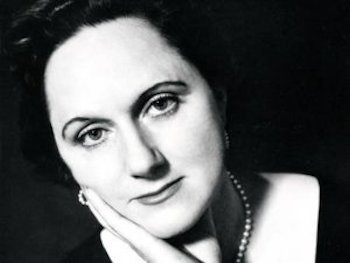
. . . . . . . . . .
Creative inspiration
In Contemporary Novelists, Elizabeth explains her process: “I write in scenes, rather than in narrative, which I find boring. I am pleased if the look of a page is interesting, broken by paragraphs or dialogue, not just one dense slab of print.”
And she speaks about the driving force of characterization in her work, in a letter to Blanche Knopf, her American publisher, in October 1948:
“People are my only adventures and I hope never to have any others; and, though I do not use their characters in my books, their company constantly replenishes me and inspires me. To be allowed to be ‘ordinary’ and live among ‘ordinary’ people (though no one is really that) is the only way that I can write, and I expect that this limits my range; but I have no gift for anything else.”
One exception, however, is Elizabeth’s 1957 novel, Angel, which was inspired by her reading of two biographies of the popular English novelist Marie Corelli, one by Eileen Bigland published in 1953 and the other by Amanda McKittrick Ros published in 1954.
In his 1995 introduction to A View of the Harbour, originally published in 1947 and later reprinted by Virago Books, Peter Kemp also observes the importance of artists in Elizabeth’s works. Particularly in A Wreath of Roses (1949) The Wedding Group (1968), and Blaming (1976), artists play a prominent role.
Artists who capture everyday life
In a 1948 letter to Ella Bellingham-Smith, Elizabeth praises her paintings as viewed in the artist’s first solo exhibition at the Leicester Gallery that year:
“I feel in all you paint, your tenderness, your modesty. I know that that is how children stand, and move, and group themselves. And the weather is constantly changing everything, and each hour of the day has its especial quality.”
As Paul Bailey later describes, in his introduction to Virago’s reissue of The Blush (first published in 1958 and reprinted in 1986): “The quotidian is Elizabeth Taylor’s province, where the ordinary are to be found extraordinary, as she thought they should.”
Writer Brigid Brophy, in her 1966 collection Don’t Never Forget: Collected Views and Reviews, describes Elizabeth’s uncanny capacity to encapsulate everyday details: “Mrs Taylor’s mastery is such that she can express her characters’ feelings about one another through their exasperation with one another’s children and chows.”
A talent for short stories
Elizabeth’s first published work was a short story in Tribune, “For Thine is the Power,” which appeared March 31, 1944. It was accepted by George Orwell, the new literary editor, having been rejected by Reginald Moore at Modern Reading the previous year.
Another story, “Better Not,” had been accepted first, but it was not published until later in 1944 in The Adelphi, edited by John Middleton Murry.
Paul Bailey, who contributed the introductions to many of Virago’s reissues of Elizabeth’s work, describes her particular talent with stories: “The short-story form is one that attracts the swift glance rather than the long, cold stare, and Elizabeth Taylor is one of the great glancers.”
Robert Liddell, who would later write about his friendship with Ivy Compton-Burnett and Elizabeth Taylor in his memoir Elizabeth and Ivy (1986), observes some autobiographical elements in her short stories. He points, for instance, to “The Letter Writers,” a story about Edmund and Emily, who have been corresponding for ten years (as, indeed, Robert and Elizabeth had been, when she wrote this story): letters provide the foundation of their friendship, despite never having met in real life.
Elizabeth’s collections appeared throughout her career: Hester Lilly (1954), The Blush (1958), A Dedicated Man (1965), and The Devastating Boys (1972). Alongside these volumes, Elizabeth also published regularly in The New Yorker, beginning with an excerpt from A View of the Harbour (1947) the year after the novel’s publication. At that time, she worked with Katharine White, and later and until 1969, with William Maxwell.
The last short story she completed was written in the hospital, while she was recovering from a cancer-related surgery: “Madame Olga,, which was published in August 1973 in McCall’s.
Posthumously, Virago published her Collected Stories in 2012: this marked the centenary of her birth and included the stories previously only published in The New Yorker.
Also in 2012, Cambridge Scholars Publishing issued Elizabeth Taylor: A Centenary Celebration, which includes some non-fiction articles, as well as two story fragments (unfinished and unpublished in her lifetime) and some academic studies.
. . . . . . . . . .
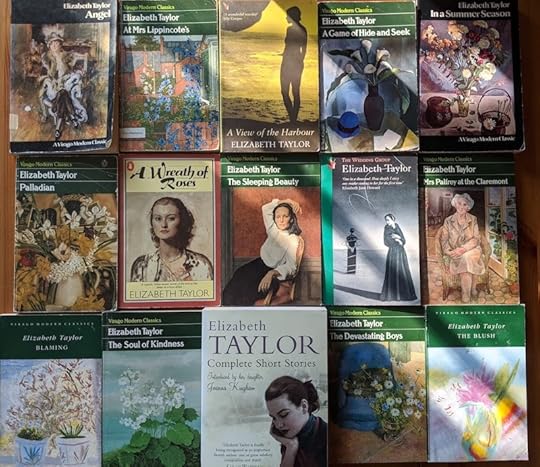
. . . . . . . . . .
Peer recognition and community
Novelist Elizabeth Jane Howard first met Elizabeth Taylor as part of the publicity for In a Summer Season (1961). Howard had prepared thirty questions for an eight-minute interview, anticipating that would be more than sufficient, but Elizabeth so quickly dispatched those queries, with ‘yes’ and ‘no’ answers, that Howard’s questions were exhausted in under two minutes.
Elizabeth was notoriously private and respected other writers’ privacy as well. When asked by her American publisher to prepare an article about Ivy Compton-Burnett, Elizabeth compiled a biographical sketch, overlooking the fact that she was given the project because she had become friends with Ivy and, as such, was expected to share personal anecdotes and provide lesser-known details about her.
Elizabeth’s writing was not universally admired, however. During her lifetime, Robert Liddell identified what he referred to as the “Lady-Novelists Anti-Elizabeth League” — said to include Kay Dick, Kathleen Farrell, Kate O’Brien, Pamela Hansford Johnson, Stevie Smith, and Olivia Manning, all of whom disparaged her work.
In 1952, Elizabeth was included in England’s Who’s Who and, in 1966, she was declared a Fellow of the Royal Society of Literature. In between, her husband’s confectionary business sold, the couple’s son and daughter each married and each had had their first child – Joanna’s in 1964 and Renny’s in 1967, and Elizabeth’s affair with Ray had ended.
In 1971, Elizabeth’s novel Mrs Palfrey at the Claremont was shortlisted for the Booker Prize, along with works by V.S. Naipaul, Derek Robinson, Thomas Kilroy, Mordecai Richler and Doris Lessing).
. . . . . . . . . .

Elizabeth Taylor page on Amazon*
. . . . . . . . . .
Elizabeth Taylor’s Legacy
In Sam Jordinson’s 2012 article “Rediscovering Elizabeth Taylor – the brilliant novelist” (The Guardian), both Paul Bailey and Elizabeth Jane Howard declare themselves envious of “any reader coming to her for the first time.” Here, Antonia Fraser identifies her “one of the most underrated writers of the 20th century.”
Hilary Mantel said that she is “deft, accomplished and somewhat underrated,” and Rosamund Lehmann describes her as “sophisticated, sensitive and brilliantly amusing”.
Consider, too, Joyce Carol Oates’s comments in theWashington Post in 1972:
“There is a distressing similarity between Taylor’s many stories – an assumption, which sometimes destroys a reader’s enjoyment of her art, that the people she deals with in her fiction are not people, but characters. They are imagined as interior creations, existing within the confines of their particular stories; and they are made to be, and even to feel, inferior.”
But for every dismissal, there is a comment like Kingsley Amis’s in The Statesman in 1971:
“Mrs Taylor is one of those novelists who look homogeneous, as if working within a single mood, and turn out to be varied and wide-ranging. There is a deceptive smoothness in her tone, or tone of voice, as in that of Evelyn Waugh; not a far-fetched comparison, for in the work of both writers the funny and the appalling lie side by side in close amity.”
Elizabeth Taylor continues to find new audiences, thanks to reissues from Virago and NYRB. From 2012 to 2014, BBC selected some of her short stories for broadcast and, more recently, Mrs Palfrey at the Claremont was a Book at Bedtime, read by Eleanor Bron, in 2018.
Mrs Palfrey at the Claremont was also made into a 2005 film (directed by Dan Ireland – from a screenplay by Ruth Sacks Caplin written for television in the 1970s – and starring Joan Plowright). And Angel was filmed in 2007 (directed by François Ozon and starring Romola Garai).
Her stories continue to resonate with readers today.
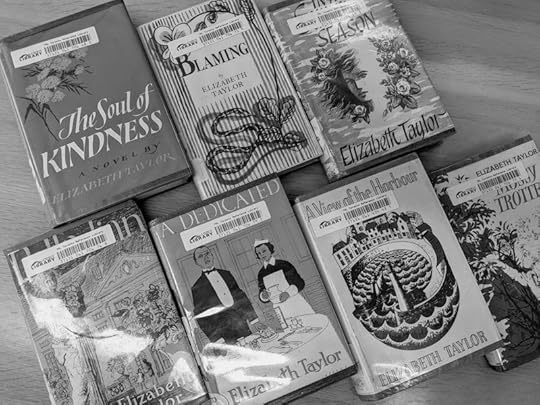
Contributed by Marcie McCauley, a graduate of the University of Western Ontario and the Humber College Creative Writing Program. She writes and reads (mostly women writers!) in Toronto, Canada. And she chats about it on Buried In Print and @buriedinprint. The Toronto Public Library played a vitally important role in the research for this piece, including assistance from the staff, in particular Leigh Turina and her onsite colleagues.
More about Elizabeth Taylor
Major Works
Novels
At Mrs. Lippincote’s (1945)
Palladian (1946)
A View of the Harbour (1947)
A Wreath of Roses (1949)
A Game of Hide and Seek (1951)
The Sleeping Beauty (1953)
Angel (1957)
In a Summer Season (1961)
The Soul of Kindness (1964)
Mossy Trotter (1967; her only children’s book)
The Wedding Group (1968)
Mrs. Palfrey at the Claremont (1971)
Blaming (1976; posthumous)
Short story collections
Hester Lilly (1954)
The Blush and Other Stories (1958)
A Dedicated Man and Other Stories (1965)
The Devastating Boys (1972)
Dangerous Calm (1995)
Complete Short Stories (2012)
Elizabeth Taylor: A Centenary Celebration (2012)
You’ll Enjoy It When You Get There: The Stories of Elizabeth Taylor (2014)
Biographies
Nicola Beauman, The Other Elizabeth Taylor (Persephone Books 2009)
Elizabeth and Ivy, ed. Robert Liddell (1986)
Film adaptations
Angel (2007)
Mrs Palfrey at the Claremont (2005)
More information and sources
“You May Have Heard of Her” by Christopher R. Beha
“The Other Liz Taylor” by Philip Hensher
“The Other Elizabeth Taylor” by Benjamin Schwarz
“How the Other Elizabeth Taylor Reconciled Family Life and Art” by Namara Smith
Reader discussion of Elizabeth Taylor’s books on Goodreads
Wikipedia
· · · · · · · · · · ·
*This is an Amazon Affiliate link. If the product is purchased by linking through, Literary Ladies Guide receives a modest commission, which helps maintain our site and helps it to continue growing!
The post Elizabeth Taylor appeared first on Literary Ladies Guide.
January 16, 2020
Charlotte Brontë Before Jane Eyre by Glynnis Fawkes
Knowing how obsessed I am with all things Brontë, my brother thoughtfully gifted me with Charlotte Brontë Before Jane Eyre, a graphic biography by Glynnis Fawkes.
Charmingly told and skillfully drawn, this book for readers of all ages covers the most famous of the brilliant literary sisters, Charlotte Brontë, from her early years to the moment she sends off the finished manuscript of Jane Eyre to a prospective publisher. Said she: “It’s sent. Now there’s nothing but forlorn hope.”
Of course, the legions of fans of Jane Eyre know how this turned out, though fewer readers know of the trials that beset the Brontë sisters — Charlotte, Emily, and Anne — from their childhoods to their premature deaths. Glynnis Fawkes captures their spirit and sorrows.
What drew Glynnis to Charlotte was similar to what I find compelling about her. In her postscript, Glynnis writes:
“Working on this project allowed me to rediscover a writer whose work I had enjoyed earlier in life, but I wan’t prepared for the love and respect for Charlotte I’ve gained in the course of my research.
Her persistence in pursuing her career against so many odds and facing such heartbreak, her imagination — from her earliest writing about the world of Glass Town to the shades of feeling she captures in Villette — are inspiring across the years. Charlotte’s humor and depth of thought have sustained me in writing and drawing this book.”
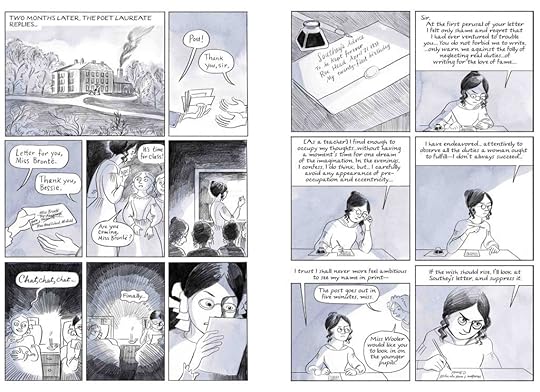
See also: Jane Eyre: A 19th-Century Analysis
I was delighted to learn that Alison Bechdel, the iconic graphic novelist best known for Fun Home, is also a Brontë fan. She supplied the introduction to this book. She writes, in part:
“Fawkes’s crisp, engaging drawings bring to life the boisterous camaraderie of the Brontë siblings, the windswept moor, a grim school dormitory, even the notoriously difficult to dramatize activities of reading and writing that Charlotte spent most of her time engaged in. We travel inside the imaginary worlds the children invented and we see the tiny, infinitesimally hand-lettered magazines that Charlotte and her brother collaborated on like mad, Victorian-era ‘zinesters.”
This book is the latest in The Center for Cartoon Studies Presents, a series of biographies (including Satchel Paige, and Annie Sullivan and Helen Keller, and more) for audiences of all ages. Images of interior pages are reprinted her with permission of the author and publisher, Disney/Hyperion ©2019.

And now, here’s Glynnis Fawkes, the author and artist, describing the process behind creating Charlotte Brontë Before Jane Eyre.:
Captivated by the Brontë sisters
I chose to write about the Brontë sisters because I was captivated by their books from when I was young: My mother read Emily Brontë‘s masterpiece, Wuthering Heights to me when I was about 13.
Many years later, in my thirties, when I was working on an archaeological excavation in Crete, I read Charlotte’s Villette and felt an immediate connection to the story of an independent woman making her way in a foreign country — despite the differences in time and place.
When my editor presented a list of subjects for the potential book, the Brontës jumped out at me. The more I read of Charlotte’s early writing, letters, and diaries, the more I appreciated her persistent spirit, sense of drama, and humor. My book centers around Charlotte for the practical reason that she left the most letters and diaries.
Research, sketching, and fact-checking
I began my research for the book by reading several biographies as well as re-reading all of the sisters’ novels and Charlotte’s earlier works. I wrote an outline of the events my book should include. The fact that it had a prescribed count of ninety pages kept the contents under pressure — otherwise it could have been a rambling three-hundred-page tome.
My editor, James Sturm, helped to shape the book — from the prologue when Charlotte is twenty and receives a letter from poet Laureate Robert Southey telling her, “literature cannot be the business of a woman’s life…” to the ending when Charlotte sends in her manuscript for Jane Eyre: “and the rest is history…”
Once I’d drawn thumbnail pages (roughly sketched images and hand-written text), I sent them to the publisher, who sent it to Brontë Scholar Juliet Barker for fact checking. She sent back a dozen pages of notes and revisions that I integrated into my draft.
At this point, I went for a month-long residency in France, and on my way I took a trip to the Brontë Parsonage Museum in Haworth, UK.
Visiting the Brontës’ house, and walking in their footsteps on the moors, made a tremendous difference when it came to evoking their world in the final drawings.

Refining the artwork, and a kinship with Charlotte
Rather than drawing the pages ink, I drew in dark (#6) pencil to achieve a more atmospheric effect. I scanned, cleaned up, and printed out my pencil drawings, then using a light table and watercolor paper, painted an ink wash.
Next, I scanned these abstract-looking pages and assembled the layers in photoshop. This is a system I learned from Alison Bechdel — and though it seems labor-intensive, it allows for control of the separate layers: you can play with the contrast of line-drawing and the ink-wash separately. The publisher converted the ink wash to a pale purple.
I made a comic about taking her to a yoga class — she would have been amazed by it. In pondering the differences between the world the Brontës knew and ours, I drew a series for The New Yorker called 19th-Century Literature with Better Birth Control.
In creating this book, I gained a feeling of kinship for Charlotte — and in the thick of it I felt like she was with me all the time.
. . . . . . . . . .
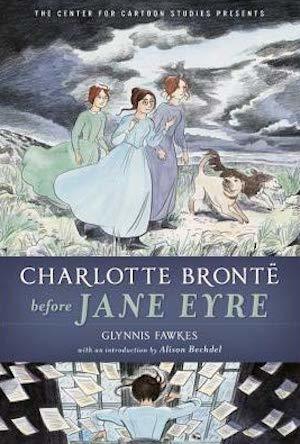
Charlotte Brontë Before Jane Eyre on Amazon*
. . . . . . . . . .
About Glynnis Fawkes: Glynnis Fawkes is a cartoonist and illustrator living in Burlington, Vermont. With a Fulbright fellowship, she published two books in Cyprus, then worked for about 9 years as illustrator on excavations around the Eastern Mediterranean.
Her books Greek Diary and Alle Ego won the Society of Illustrators MoCCA Arts Festival Awards in 2016 and 2017, and she has been nominated for an Ignatz Award. Her cartoons have appeared many times on The New Yorker.
Her books Charlotte Bronte Before Jane Eyre (Disney/Hyperion) and Persephone’s Garden (Secret Acres) were published in 2019. She has received a Vermont State Arts Council Creation Grant and the School of the Museum of Fine Arts Travel fellowship toward the completion of her next book, a middle grade adventure set in Late Bronze Age Greece and Egypt. Visit her at GlynnisFawkes.com.
. . . . . . . . . .
*This is an Amazon Affiliate link. If the product is purchased by linking through, Literary Ladies Guide receives a modest commission, which helps maintain our site and helps it to continue growing!
The post Charlotte Brontë Before Jane Eyre by Glynnis Fawkes appeared first on Literary Ladies Guide.



